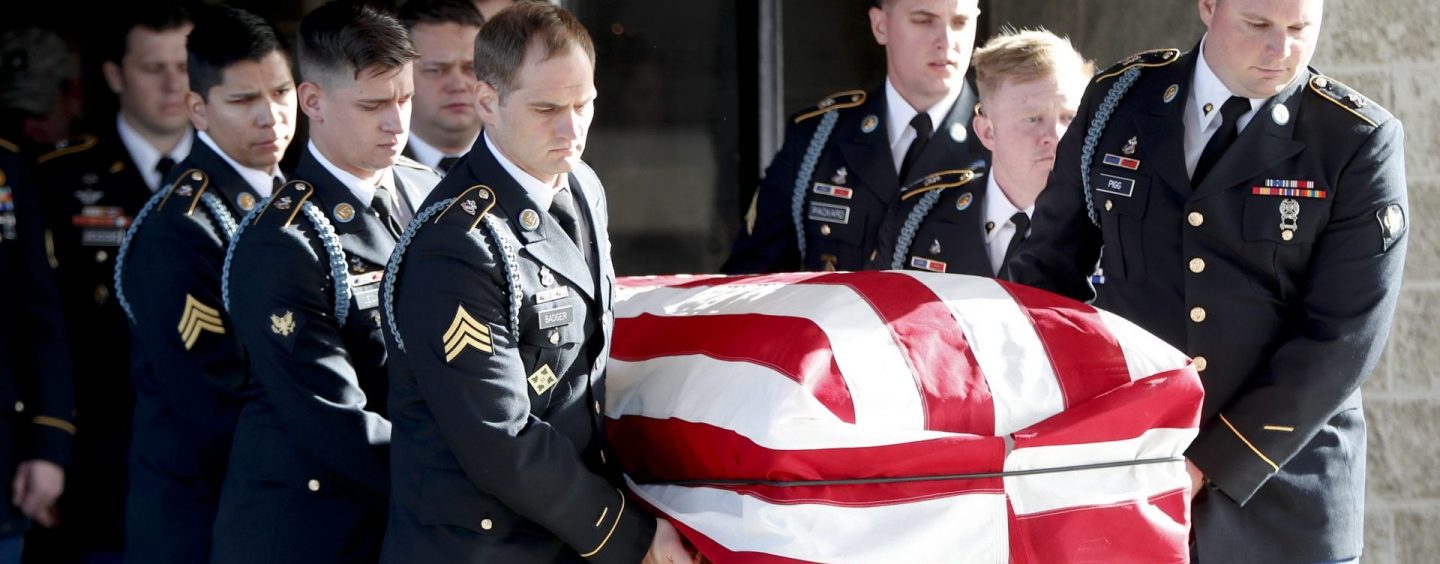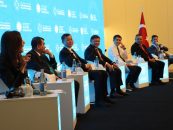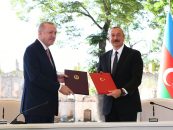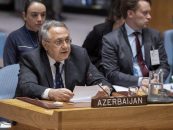By Lt. Gen. Clarence E. McKnight Jr. (U.S. Army, Ret.), Dr. David Leffler, Duncan Brown, Dr. Carla Brown and Arlene J. Schar
EDITOR’S NOTE:
The article below was published in 2017 in several locations worldwide. Azerbaijan Today is reprinting it in hopes that military leaders in Azerbaijan and elsewhere will consider deploying Invincible Defense Technology (IDT) to create lasting peace.
A suicide bomber and gunners outside the Kabul Airport in Afghanistan have killed dozens of people, including 13 US service members. The evacuation efforts while heroic have been chaotic and could have been handled better to get everyone out while avoiding loss of life. All of this including the 20 year in Afghanistan war itself could have been avoided if Invincible Defense Technology (IDT) had been properly deployed.
Perhaps readers agree that this is an important lesson for all of us.
Military leaders in the United States were amazed at how quickly Afghanistan fell. Similar situations could occur again elsewhere, perhaps even in Azerbaijan.
Tensions in the South Caucasus are currently at a dangerous high.
Azerbaijan has a powerful and respected military. But no matter how powerful, if large scale warfare breaks out the consequences would be devastating. It is not yet too late for the Azerbaijan military to deploy IDT to calm the rising tensions that culminate in war.
According to co-author Dr. David Leffler, other countries are currently considering the deployment of a global IDT system. Dr. Leffler requests that military leaders go to this website and do a webpage search on names of countries such as: “Armenia,” “Ukraine,” “Russia,” “Pakistan,” “China,” or any other country of reader’s choice. He asserts that word is getting out regarding IDT and that wise intelligence analysts would conclude that one of these countries will eventually deploy IDT. (Regarding Ukraine: he requests leaders go to this webpage and do a page each on the word: “Ukraine.” In particular watch the online video of first stage Ukrainian implementation of IDT.)
Dr. Leffler calls on the Azerbaijan military to achieve the great historical honor of being the first military to deploy IDT to be operational on a global level. (When this was done using a civilian group, terrorism dropped 72% worldwide). He wants wise and learned military leaders to realize the only way to become truly invincible is to not have any enemies.
The extensive research on IDT indicates that if the Azerbaijan military chooses to be the first military to globally deploy IDT to prevent the birth of enemies, its military would become famous for achieving “victory before war” and true invincibility. According the the peer-reviewed research cited in the article below, by creating a Preventative Wing of the Military consisting of about 10,000 to 15,000 military personnel trained in the IDT techniques, Azerbaijan could actually become the catalyst for creating lasting world peace. That is why Dr. Leffler asserts that the wise military leader who accomplishes this great historical achievement will become the world’s most famous military leader. Throughout history military leaders have won great battles, but they have never been truly invincible because they could not avert the creation of enemies.
If Dr. Leffler and the cited peer-reviewed research in this article are correct and Azerbaijan acts quickly, perhaps lasting world peace is finally in our reach within our lifetimes.
Abstract
The current perception of U.S. military leaders is that we live in a dangerous world, one filled with enemies that require the next level of disruptive technologies to subdue. Three properties define such technologies. They are unexpected, they hit enemies in a weak spot, and they cannot be avoided.
From Pearl Harbor, to the nuclear weapons at the end of World War II, to the attacks on 9/11, disruptive technologies have proven impact, but they can suffer from problems. For example, tactical disruptive technologies have a limited force-multiplying effect. Strategic disruptive technologies (e.g. nuclear weapons), on the other hand, are dangerous to those who use them and are no longer held only by the U.S. To maintain its leadership in the world, the U.S. needs a new kind of disruptive technology.
For maximum effectiveness, disruptive technologies must accomplish more than before. They must not only challenge enemies, but completely disable them. One such possibility is called “Invincible Defense Technology.” This recently developed approach is inexpensive, scalable, and has proven effectiveness, as described in eighteen peer-reviewed studies [see APPENDIX]. Its effects are irresistible, i.e. enemies are unable to stop them. By applying this human resource-based, non-lethal, non-destructive technology, militaries can prevent enemies from arising.
Former U.S. Secretary of Defense William Perry called preventive defense “our most important tool for protecting American interests from the special dangers that characterize the post-Cold War era”–keeping potential challenges to security “from becoming full-blown threats.”
Just as preventive medicine supports health, eliminating disease and minimizing the need for surgery, preventive defense can “make war less likely and deterrence unnecessary,”[i] according to Perry.
Although he was not commenting on the technologies described in this article, Perry emphasized that preventive defense is forward looking, not passive or philanthropic. He wrote: “It’s about hard work and ingenuity today, so that we don’t have to expend blood and treasure tomorrow.”[ii]
The ultimate disruption to war is effective prevention. We suggest organizing Prevention wings incorporating a daily routine for military personnel including large group practice of the Transcendental Meditation® (TM) technique.[iii] and TM-Sidhi® techniques.[iv] This approach has come to be known as Invincible Defense Technology (IDT), because in addition to prevention, the techniques have been documented to develop individual and group resilience.
Additionally research has documented significant reduction in war and violence when sufficient numbers make use of these techniques in a group. Foremost independent leaders in the field of conflict management have endorsed this approach. David Edwards, University of Texas professor observed, “The impact of this research exceeds that of any other ongoing social or psychological research program.”[v]
Military personnel practice the TM and TM-Sidhi techniques twice a day, seven days a week, preferably in a secure location near the targeted population. Although the TM technique comes from the ancient Vedic tradition of India, it requires no belief changes and is non-religious.
The Transcendental Meditation technique (TM) is a simple, natural, and easy-to-learn procedure that allows the ordinary thinking process to become more settled, resulting in a unique psychophysiologic state of restful alertness. Restful alertness is characterized by slower and shallower respiratory rates, optimized sympathetic tone and reduced hypothalamic-pituitar-adrenal axis activity, along with high electroencephalography coherence. The TM technique is practiced twice a day while sitting comfortably with eyes closed. Students are taught by certified instructors using standardized protocols.[vi]
The practice of Transcendental Meditation has been evaluated in 395 peer reviewed studies to help improve mental and physical health and wellbeing.[vii] The National Institutes of Health have funded over $20 million of research on TM over the last 20 years. Recently published clinical trials and meta-analyses have shown reductions in: high blood pressure, hardening of the arteries, insulin resistance, anxiety, smoking, alcohol use and a nearly 50% reduction in risk of heart attack, stroke or death with practice of the TM technique.[viii] The technique has also been found to reduce physiological and pathological results of chronic stress.[ix][x]
The TM technique has been demonstrated to improve development and resilience in soldiers, to improve wellness, and to dramatically reduce burnout and symptoms of post-traumatic stress.[xi]
During TM practice, brain functioning becomes more integrated–individual modules are connected into larger, functioning networks. Development of brain integration and EEG coherence through TM has been correlated with improvements in attention, intelligence,[xii] creativity,[xiii] learning,[xiv] [xv] and memory[xvi] in all age groups.
On a day-to-day basis, significant, measurable, and efficient rest, and enhanced brain functioning, dramatically impact performance. As a disruptive technology used by a military unit, rest and improved brain functioning are, in essence, multiplied to affect the whole group. Human consciousness appears to exhibit a field character so that coherent sub-populations generate coherence in an underlying field of consciousness that spontaneously enlivens the same coherence in others in the environment.”[xvii]
Twenty-three peer-reviewed studies have documented increased societal coherence or orderliness resulting from group practice of the TM and more advanced TM-Sidhi techniques, including measurable and significant reductions in crime, war and terrorism. The findings suggest that a sufficient number of people experiencing physiological correlates of brain coherence and stress reduction have the capacity to achieve drastic tension reduction within their units and within surrounding social groups.[xviii]
Militaries in Latin America deploying this preventive approach have already realized that, unlike Perry’s prediction, IDT is not hard work. Developing nations in Latin America are driven by economic necessity. They realize that with IDT it is no longer necessary to dedicate a large portion of their GNP to defense. For them, the cost to implement IDT is less than that of a modern fighter jet. IDT also provides the added advantage of requiring minimal time and training to utilize. For this reason, it is highly cost-effective.
Bottom line, IDT functions as a disruptive technology by removing the individual and societal stresses that create enemies and that foster conflict. Scientific evidence reveals that the underlying cause of war, violence, crime and terrorism is high levels of collective societal stress. When the IDT technology is properly applied, stress levels throughout the surrounding population are rapidly reduced. Remove the stress, and potential enemies can find other, non-violent and less destructive ways to handle problems and differences.
IDT’s societal calming effect is backed by studies carried out in the Middle East, Africa, Southeast Asia, and Latin America.[xix] It has also been measured globally in a study published in the Journal of Offender Rehabilitation which used data provided by the Rand Corporation.[xx] During the years 1983 – 1985 when large groups of civilian IDT experts gathered together, terrorism-related casualties decreased 72%, international conflict decreased 32%, and overall violence was reduced in the family of nations, all without intrusion by other governments.
In 1983, a civilian IDT group stationed in Israel decreased the intensity of war in the Lebanon conflict by 45%, with results starting within just 48 hours. A summary of the study was published in the Journal of Conflict Resolution[xxi] (JCR) (see figure below taken from this pioneering study) and follow-up studies followed in the Journal of Social Behavior and Personality[xxii] and the Journal of Scientific Exploration.[xxiii]
As the group size of IDT experts varied day to day in nearby Jerusalem, Lebanon war-related fatalities varied in an inverse relationship to group size. When IDT participant numbers reached their highest point, war deaths dropped by 76% as IDT experts approached the theoretically predicted threshold of the square root of 1% of the population.
A longitudinal study replicated, extended, and improved on the JCR study examining seven assemblies of IDT practitioners over a two and a quarter year period at the height of the Lebanon war. Statistical analysis indicated:
- War-related fatalities decreased by 71%,
- War-related injuries fell by 68%,
- The level of conflict dropped by 48%, and
- Cooperation among antagonists increased by 66%.[xxiv]
These findings of the effects of reducing collective societal stress and conflict are the most rigorously established phenomenon in the history of social science research. The likelihood that these combined results were due to chance is less than one part in ten to the nineteenth.[xxv]

The figure above illustrates a highly statistically significant correlation between the number of participants in an IDT assembly and a composite index measuring progress toward peace and quality-of-life in Israel during August and September of 1983. When the number of participants rose, the intensity of the war in Lebanon decreased (p < 10-7).
Worldwide the experience with IDT has demonstrated growth of prosperity and increased economic incentives in highly stressed areas. Entrepreneurship and individual creativity also increase. Due to civilians’ increased calmness, a more productive and balanced society emerges because its citizens’ aspirations rise. Violence as an expression of discontent is naturally disallowed as a means for change.

Deployment of IDT brings about these positive changes in social trends within just a few weeks, or for some within a few days, after it is properly applied. The changes are indicated by such measures as reductions in terrorism, crime rates, infant mortality, accidents, hospital admissions, etc. After such profound societal changes occur, the ground for war and terrorism is eliminated.[xxvi]
How does Invincible Defense Technology Work?
The cycle of war (and terrorism when the war is fought underground) is caused by the build-up of social stress. In the past powerful and plentiful weaponry was meant to deter enemies. When deterrence failed, the military was called in to fight. Post-war, the fighting may have temporarily solved the problem by eliminating the symptoms. But there is a ticking time-bomb if the collective stress remains. Stress eventually builds up again, thus fueling future conflicts and wars. Consider today’s challenge: terrorists know they cannot compete in a conventional war, so they use inexpensive terrorist attacks that are extremely difficult to predict, prevent or control with conventional war-making personnel and skill sets.
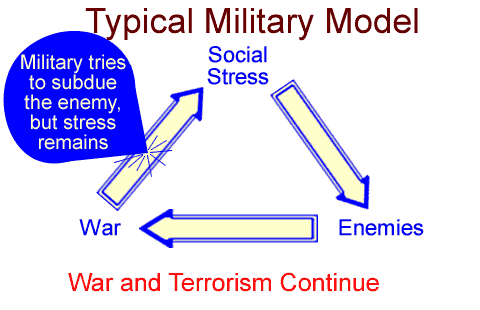
Latin American leaders have realized that, even if they could afford to finance a strong technologically superior military, they still would suffer from terrorism, war and casualties. Instead, they are choosing to adopt the IDT model where their military becomes not only strong (more resilient and focused military personnel), but more invincible by abating the collective social stress responsible for war and terrorism. With IDT the war cycle is broken because their military directly addresses the collective social stress and prevents or pacifies the enemy. It is in this sense that we can say their military becomes invincible: it no longer has an enemy it has to fight. No enemy means no war and no terrorism.
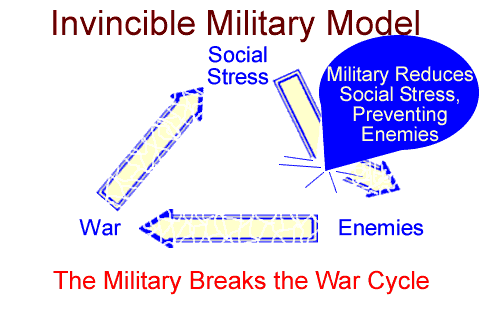
A quantitative advantage may have been relevant in the past for militaries dealing with conventional weaponry or even nuclear, biological or chemical weapons. However, since these weapons do not affect the underlying conditions that continuously foster conflicts and wars, they are not the solution needed.
A quantitative advantage is gained when a military deploys large numbers of IDT experts. The field effect thus produced provides a strategic advantage by protecting their nation. And, if the group is large enough, this advantage also benefits nearby nations because the larger field effect calms tensions in their countries as well, protecting everyone from potential adversaries.
IDT provides the ultimate level of autonomy–total freedom from external influence or control. This is the true level of independence. When IDT is properly applied, a powerful field effect of collective consciousness is created. Any intentions for enemies to commit hostile acts are deflected by more powerful influences of collective consciousness. This naturally happens in a process similar to the Meissner Effect; where a superconducting magnetic field repels the influence of an intrusive external magnetic field.[xxvii]

To the DoD’s credit, the practical component of IDT, the TM technique, is being utilized and investigated as a means to alleviate PTSD and build resilience. The technique has been proven and adopted as part of the training of America’s future commanders at Norwich University,[xxviii] the nationally-respected, and oldest military academy in the USA.[xxix] In addition, some US warriors with PTSD learned the TM technique as part of their treatment at the Eisenhower Army Medical Center.[xxx]
Regarding utilizing the more advanced practices of IDT to prevent terrorism and war; little headway has been made with a few exceptions. Col. Brian Rees, a respected retired US Army Command Surgeon who was featured in Stripes and published in Military Medicince, [xxxi] published his US Army War College (USAWC) Masters research paper on the topic of IDT–“The Application of Strategic Stress Management in Winning the Peace.”[xxxii] Later an IDT synopsis titled: “An Overlooked, Proven Solution to Terrorism” was published in a USAWC sponsored report titled: “55 Trends Now Shaping the Future of Terrorism.”[xxxiii]
The US military would create five Prevention Wings of the Military, one for each border of the country, set up near the borders of East, West, North and South, and one in the center of the country.[xxxiv]
IDT cannot be used against a country, except in the sense that if a possible adversary or trouble-spot is identified, the IDT could be applied locally in that area by locating members of the IDT experts at U.S. bases or in cooperation with allies. If the US did not have Prevention Wings or if for some reason they were not operational and tensions rose in the US, neighboring countries could use their Prevention Wings to lower tension. If one considers that if a large enough Prevention Wing were established somewhere that exceeded at least the square root of one percent of the world’s population, then a country anywhere in the world could lower tensions not only in their nation, but worldwide.
The international classic, Sun Tzu’s Art of War, advises that it is better to win without fighting,[xxxv] which is why militaries are now deploying IDT as a proven technology to harness the most powerful level of natural law to gain victory. It is time for the US military to use IDT to achieve the highest ideal of professionalism–preventing the birth of an enemy.
About the authors:
Lt. Gen. Clarence E. McKnight, Jr., (U.S. Army Ret.) graduated from West Point in 1952. He served in the Korean War and commanded two Signal Battalions in Vietnam. Clarence commanded three Signal Battalions in Europe, including commander, 5th Signal Command/deputy chief of staff for communications-electronics, U.S. Army Europe. He served as commandant of the U.S. Army Signal Center and School, and commander, U.S. Communications Command. Lt. Gen. McKnight served tours of Ft. Gordon, Georgia, and Ft. Huachuca, Arizona, and concluded his career as Director of Command, Control and Communications Systems for the Joint Chiefs of Staff in Washington, D.C. He is the author of the book: From Pigeons to Tweets: A General Who Lead Dramatic Changes in Military Communications,” and received the 2008 Distinguished Graduate Award at Westpoint. His military awards are listed here.
Dr. David Leffler has a Ph.D. in Consciousness-Based Military Defense and has served as an Associate of the Proteus Management Group at the Center for Strategic Leadership, US Army War College. Currently, he serves as the Executive Director at the Center for Advanced Military Science (CAMS) and lectures and writes worldwide about IDT. Dr. Leffler’s editorial “Creating an Invincible Military” was featured in Fox News. He is available on Twitter and Facebook.
Duncan Brown, M.A. is co-director of the Center for Leadership Performance in Chicago, co-leading a course entitled Physician Wellness through the Transcendental Meditation technique at Loyola University Chicago Stritch School of Medicine. Duncan has experience as a writer, editor, newspaper reporter, trainer and network engineer. He is also a part-time professional movie reviewer.
Carla Brown, Ed.D. is a Harvard-trained adjunct professor at Loyola University Stritch School of Medicine and co-director of the Center for Leadership Performance in Chicago. She co-leads Physician Wellness through the Transcendental Meditation technique at Loyola Stritch. She is a researcher, mentor, trainer, speaker and group facilitator.
Arlene J. Schar is Director of Communications at the Center for Advanced Military science CAMS). She has served since 2015 as Executive Assistant at CAMS to Dr. David Leffler, providing support for all of his activities, including research, editing, correspondence, reports, calendar management, and orchestrating all lecture and travel arrangements. She is an avid advocate of Invincible Defense Technology, and her articles have been published in over 400 locations worldwide.
REFERENCES:
[i] Pexton, P. (1996, June 3). Secretary stresses diplomacy as first step ‘preventive defense’ is what he calls it. Air Force Times, p. 20.
[ii] ibib. For a thorough description of former Secretary of Defense William J. Perry’s concept of preventive defense, see: “Defense in an Age of Hope,” Foreign Affairs, 75, (6), November/December 1996, 64-79. Available at: https://www.foreignaffairs.com/articles/1996-11-01/defense-age-hope
[iv] http://permanentpeace.org/technology/sidhi.html
[v] https://www.gusp.org/defusing-world-crises/endorsements.html See also conference report: https://www.gusp.org/global-peace-summit/
[vi] Nidich, S., Rainforth, M., Haaga, D., et al. (2009). A randomized controlled trial on effects of the Transcendental Meditation Program on blood pressure, psychological distress, and coping in young adults. American Journal of Hypertension, 22(12), pps. 1326-1331. Available at: https://www.ncbi.nlm.nih.gov/pmc/articles/PMC3128829/
[vii] Chalmers, R MD. (2017) Research Publications on Transcendental Meditation: Bibliography (self published) See http://www.researchuse.org/TMResearch/Chalmers_Summary.pdf
[viii] Institute for Natural Medicine and Prevention, Maharishi University of Management, Iowa, USA (2008) A new clinically-proven technique to reduce cardiovascular disease and its risk factors: Scientific evidence of the clinical efficacy and cost effectiveness of the Transcendental Meditation® Program (Booklet) p. 2. Available at: https://www.mum.edu/assets/pdf_resources/fds09_healthbenefitstm.pdf
[ix] http://www.researchuse.org/TMHeartHealth/
[x] Orme-Johnson DW, Barnes VA. (2013). Effects of the Transcendental Meditation Technique on trait anxiety: a meta-analysis of randomized controlled trials. Journal of Alternative and Complementary Medicine, 19:1-12.
[xi] Rees B. Overview of outcome data of potential meditation training for soldier resilience. Military Medicine, 2011 Nov; 176(11):1232-42. Available at: http://militarymedicine.amsus.org/doi/pdf/10.7205/MILMED-D-11-00067
Rees B, Travis F, Shapiro D, Chant R., Reduction in posttraumatic stress symptoms in Congolese refugees practicing Transcendental Meditation. Journal of Traumatic Stress. 2013 Apr; 26(2):295-8. doi: 10.1002/jts.21790. Abstract available at: https://www.ncbi.nlm.nih.gov/pubmed/23568415
Rees B, Travis F, Shapiro D, Chant R. Significant reductions in posttraumatic stress symptoms in Congolese refugees within 10 days of Transcendental Meditation practice. Journal of Traumatic Stress. 2014 Feb; 27(1):112-5. Abstract available at: https://www.ncbi.nlm.nih.gov/pubmed/24515537
[xii] Cranson, R.W., et al. Transcendental Meditation and improved performance on intelligence-related measures: A longitudinal study. Personality and Individual Differences 12: 1105-1116, 1991. Available at: http://psycnet.apa.org/record/1992-11617-001
[xiii] Orme-Johnson, D.W., and Haynes, C.T. (1981). EEG phase coherence, pure consciousness, creativity, and TM-Sidhi experiences. International Journal of Neuroscience, 13, 211-217. Available at: http://www.tandfonline.com/doi/abs/10.3109/00207458108985804
[xiv] Travis, Haaga DA, Hagelin J, Tanner M, Nidich, Gaylord-King C, Grosswald S, Rainforth M, Schneider RH. (2009) Effects of Transcendental Meditation practice on brain functioning and stress reactivity in college students. International Journal of Psychophysiology, 71, 2, pps. 170-176. Available at: https://www.ncbi.nlm.nih.gov/pubmed/18854202
[xv] So, KT and Orme-Johnson, DW. (2001) Three randomized experiments on the longitudinal effects of the Transcendental Meditation technique on cognition, Intelligence, V29, 5, 2001, pps. 419-440. Available at: https://www.ncbi.nlm.nih.gov/pmc/articles/PMC3128829/
[xvi] Sanford, I. Nidich,1 Robert H. Schneider, Randi J. Nidich, Gloria Foster, Hari Sharma, John Salerno, Rachel Goodman and Charles N. Alexander (2005) Effect of the Transcendental Meditation Program on Intellectual Development in Community-Dwelling Older Adults, Journal of Social Behavior and Personality 17, no. 1: pps 217-28. Available at: https://www.researchgate.net/publication/284098300_Effect_of_the_transcendental_meditation_program_on_intellectual_development_in_community-dwelling_older_adults
[xvii] Alexander, Charles and David Orme-Johnson. (1983). “International Peace Research Project: Proposal for Israel.” unpublished. Available at: http://www.researchuse.org/articles/1983-alexander-orme-johnson-resolving-conflict.pdf
[xviii] Orme-Johnson, DW, Alexander, CN, Davies, JL, Chandler, HM, and Larimore, WE. (1988) International Peace Project in the Middle East: The Effects of the Maharishi Technology of the Unified Field, Jouurnal of Conflict Resolution, 32 (4), pps. 776-812. Abstract available at: http://journals.sagepub.com/doi/abs/10.1177/0022002788032004009
[xix] Leffler, DR, Kleinschnitz, K, and Walton, KG (1999, May 1). An alternative to military violence and fear-based deterrence: Twenty years of research on the Maharishi Effect. Security And Political Risk Analysis (SAPRA). Available at: http://www.davidleffler.com/1999/sapraalternative/
[xx] ibid. https://www.tandfonline.com/doi/abs/10.1300/J076v36n01_13
[xxi] ibid. https://www.jstor.org/stable/174032?refreqid=excelsior%3A9351855cd3928c007248026203110ab2
[xxii] ibid. https://www.proquest.com/openview/a93ecedbf88691bfa330ef91b6e92e50/1?pq-origsite=gscholar&cbl=34113
[xxiii] Orme-Johnson, DW, and Oates, RM. (2009). A Field-Theoretic View of Consciousness: Reply to Critics. Journal of Scientific Exploration, 23 (2), pp. 139-166, 2009 0892-3310/09 Available at: https://www.scientificexploration.org/docs/23/jse_23_2_johnson.pdf
[xxiv] Davies, JL, and Alexander CN. (2005). Alleviating political violence through reducing collective tension: Impact Assessment analysis of the Lebanon war. Journal of Social Behavior and Personality, 17(1), 285-338. Summary available at: http://davidleffler.com/2011/sapratableii/#b13
[xxv] ibid.
[xxvi] Orme-Johnson, DW, (2005). Quantifying the field effects of consciousness: From increased EEG coherence to reduced international terrorism. Proceedings: Bridging Worlds and Filling Gaps in the Science of Healing. Corona del Mar, CA: Samueli Institute for Informational Biology, pp. 326-346. (R.A. Chez, editor) Available at: http://www.davidleffler.com/2002/quantifying_physics_orme-johnson/
[xxvii] “An Important Message for All Military Leaders from the Executive Director of the International Center for Invincible Defense, Dr. John Hagelin.” Available at: http://www.istpp.org/military_science/Hagelin_military_lecture.html
[xxviii] Winter, C. (2013, February 7). Transcendental Meditation May Help Stressed Vets: The military is studying meditation as a means of combating America’s PTSD epidemic. Bloomberg Business Week. Available at: https://www.bloomberg.com/news/articles/2013-02-06/transcendental-meditation-may-help-stressed-vets
[xxix] David Lynch Foundation (2012, May 3). Video: Meditation Improves Performance at Military University. Available at: https://www.youtube.com/watch?v=oIH0913lQe0
[xxx] U.S. Army, FORT GORDON, Ga. (2014, December 11). Transcendental meditation: A path to healing. Available at: https://www.army.mil/article/139778/
[xxxi] Institute of Science, Technology and Public Policy – Center for Advanced Military Science (CAMS) Colonel (Ret.) Brian M. Rees, M.D., M.P.H., Medical Corps, US Army Reserve, Co-Director of Invincible Defense for the United States; Bio available at: http://www.istpp.org/military_science/#rees
[xxxii] Rees, BM (2007, May 2): USAWC PROGRAM RESEARCH PAPER: The application of Strategic Stress Management in winning the peace. United States Army War College, Carlisle Barracks, Pennsylvania 17013. Available at: http://www.istpp.org/military_science/Col_Rees_Masters_Paper.html
[xxxiii] Leffler, DR “An Overlooked, Proven Solution to Terrorism Comments About Invincible Defense Technology” Excerpts about Invincible Defense Technology taken from a 254-page report: “55 Trends Now Shaping the Future of Terrorism” edited by Dr. Marvin J. Cetron and Owen Davies. The Proteus Trends Series, Volume 1, Issue 2. Issued Feb 2008. Excerpted from 55 Trends Now Shaping the Future of Terrorism, a US government report sponsored by the Joint Information Operations Program Office (JIOPO), the Central Intelligence Agency (CIA), the Defense Intelligence Agency (DIA), and the National Security Agency (NSA). Available at: http://davidleffler.com/2011/terrorism-trends/
[xxxiv] Maharishi Mahesh Yogi. (1996). Maharishi’s absolute theory of defense. India: Age of Enlightenment Publications, p. 9. Available at: https://www.amazon.com/Maharishis-Absolute-Theory-Defence-Invincibility/dp/8175230002
[xxxv] “For to win one hundred victories in one hundred battles is not the acme of skill. To subdue the enemy without fighting is the acme of skill.” P. 77, Sun Tzu (1963). Sun Tzu The Art of War. (Samuel B. Griffith, Trans.). NY: Oxford University Press. Available at: https://www.amazon.com/SUN-TZU-ART-Samuel-Griffith/dp/B000TZGHIU/ref=sr_1_fkmr0_3?s=books&ie=UTF8&qid=1493233865&sr=1-3-fkmr0&keywords=Samuel+B.+Griffith%2C+Trans.%29.+NY%3A+Oxford+University+Press.+Sun+Tzu+The+Art+of+War.
Editor’s Note: This relevant peer-reviewed study below was printed after this paper was published in August 2017:
L. Fergusson and K. L. Cavanaugh (2019). Socio-political violence in Cambodia between 1990 and 2008: An explanatory mixed methods study of social coherence. Studies in Asian Social Science, 6(2), 1-45.
APPENDIX:
18 Peer-Reviewed, Published Articles that Empirically Evaluate the Maharishi Effect
Assimakis P., and Dillbeck, M. C. (1995). Time series analysis of improved quality of life in Canada: Social change, collective consciousness, and the TM-Sidhi program. Psychological Reports 76(3), 1171-1193.
Cavanaugh, K. L., and Dillbeck, M. C. (2017). The contribution of proposed field effects of consciousness to the prevention of U.S. accidental fatalities: Theory and empirical tests. Journal of Consciousness Studies, 24(1-2), 53-86.
Cavanaugh, K. L, and Dillbeck, M. C. (2017). Field effects of consciousness and reduction in U.S. urban murder rates: Evaluation of a prospective quasi-experiment. Journal of Health and Environmental Research, 3(3-1), 32-43.
Davies, J. L., and Alexander, C. N. (2005). Alleviating political violence through reducing collective tension: Impact assessment analysis of the Lebanon war. Journal of Social Behavior and Personality, 17(1), 285-338.
Dillbeck, M. C. (1990). Test of a field theory of consciousness and social change: Time series analysis of participation in the TM-Sidhi program and reduction of violent death in the U.S. Social Indicators Research, 22(4), 399-418.
Dillbeck, M. C., Banus, C. B., Polanzi, C., and Landrith III, G. S. (1988). Test of a field model of consciousness and social change: The Transcendental Meditation and TM-Sidhi program and decreased urban crime. The Journal of Mind and Behavior 9(4), 457-486.
Dillbeck, M. C., and Cavanaugh K. L. (2016). Societal violence and collective consciousness: Reduction of U.S. homicide and urban violent crime rates. SAGE Open, 6(2), 1-16.
Dillbeck, M. C., and Cavanaugh K. L. (2017). Group practice of the Transcendental Meditation and TM-Sidhi program and reductions in infant mortality and drug-related death: A quasi-experimental analysis. SAGE Open, 7(1), 1-16.
Dillbeck, M. C., Cavanaugh, K. L., Glenn, T., Orme-Johnson, D. W., and Mittlefehldt, V. (1987). Consciousness as a field: The Transcendental Meditation and TM-Sidhi program and changes in social indicators. The Journal of Mind and Behavior 8(1), 67-104.
Dillbeck, M. C., Landrith III, G. S., and Orme-Johnson, D. W. (1981). The Transcendental Meditation program and crime rate change in a sample of forty-eight cities. Journal of Crime and Justice 4, 25-45.
Hagelin, J. S., Orme-Johnson, D. W., Rainforth, M., Cavanaugh, K., and Alexander, C. N. (1999). Results of the National Demonstration Project to Reduce Violent Crime and Improve Governmental Effectiveness in Washington, D.C. Social Indicators Research, 47, 153-201.
Hatchard, G., and Cavanaugh, K. L. (2017). The effect of coherent collective consciousness on national quality of life and economic performance indicators–An analysis of the IMD index of national competitive advantage. Journal of Health and Environmental Research, 3(3-1), 16-31.
Hatchard, G. D., Deans, A. J., Cavanaugh, K. L., and Orme-Johnson, D. W. (1996). The Maharishi Effect: A model for social improvement. Time series analysis of a phase transition to reduced crime in Merseyside metropolitan area. Psychology, Crime and Law, 2(3), 165-174.
Orme-Johnson, D.W. (2016). Factor analysis of social indicators in the Middle East: Effects of cultural, military, political, and climatic events and group practice of the Transcendental Meditation and TM-Sidhi Program. Journal of Maharishi Vedic Research Institute, 1(1), 5-39.
Orme-Johnson, D. W., Alexander, C. N., and Davies, J. L. (1990). The effects of the Maharishi Technology of the Unified Field: Reply to a methodological critique. Journal of Conflict Resolution, 34(4), 756-768.
Orme-Johnson, D. W., Alexander, C. N., Davies, J. L., Chandler, H. M., and Larimore, W. E. (1988). International peace project in the Middle East: The effect of the Maharishi Technology of the Unified Field. Journal of Conflict Resolution, 32(4), 776-812.
Orme-Johnson, D. W., Dillbeck, M. C., Alexander, C. N., Chandler, H. M., and Cranson, R. W. (2008). Preventing Terrorism and International Conflict: Effects of large assemblies of participants in the Transcendental Meditation and TM-Sidhi program on reducing international conflict and terrorism. Journal of Offender Rehabilitation, 36(1-4), 283-302.
Orme-Johnson, D. W., and Oates, R. M. (2009). A field-theoretic view of consciousness: Reply to critics. Journal of Scientific Exploration, 23(2), 139-166.

